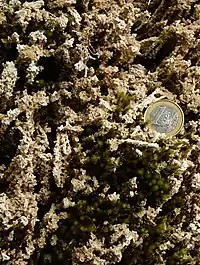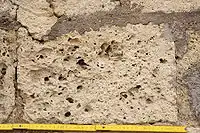Travertine
Travertine is a terrestrial sedimentary rock. It is a natural chemical precipitate of carbonate minerals; aragonite or calcite. This happens from solution in ground and surface waters, and/or geothermally heated hot-springs.[1][2] Similar (but extremely porous) deposits formed from ambient-temperature water are known as tufa.

Travertine terraces at Mammoth Hot Springs, Yellowstone National Park

Calcium-carbonate-encrusted, yet growing moss, early stage of porous travertine formation.
References
- Dictionary of geological terms, 1962. A Dolphin Reference Book
- A glossary of karst terminology, 1970. Geol. Surv. Water-Supply Paper 1899-K, U. S. Gov. Print. Off., Washington.

Travertine in a 400 year old wall of the castle Hohen Tübingen. The material is extremely hard and weatherproof. The cavities and impurities - remnents of small debris, scrub and biotic materials - make the rock porous and lightweight.
This article is issued from Wikipedia. The text is licensed under Creative Commons - Attribution - Sharealike. Additional terms may apply for the media files.